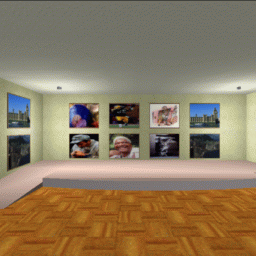 |
Hybrid Geometry- and Image-Based Modeling and Rendering for Interactive Visualization of Architectural Interiors |
 |
Hybrid Geometry- and Image-Based Modeling and Rendering for Interactive Visualization of Architectural Interiors |
| We are developing a system for interactive walkthroughs of interiors of immersive 3D
environments for real places. Such a system requires both very high level of photorealism
and real-time rendering of large, complex, highly concave environments. Applications of
this system include education, commerce, training, virtual meetings, and entertainment. Traditional computer graphics uses geometric and physics information to synthesize images. Using this traditional approach, to get photorealistic results, the geometric model has to be very detailed, and the image synthesis algorithms have to be very complex. Creating a detailed geometric model by hand is difficult, time-consuming, and error prone, and devices for automatic acquisition of 3D models are expensive and limited to small objects. Besides, photorealistic rendering of complex models is still far from real-time rates. An alternative to the traditional approach is image-based modeling and rendering (IBMR). IBMR systems acquire a collection of images of a environment, reconstruct from these images the plenoptic function of the environment, and create new images by resampling the plenoptic function at new viewing parameters. IBMR systems give us shorter modeling times, faster rendering speeds (independent of scene complexity), while maintaining high level of photorealism. These are some desirable properties of IBMR systems:
There is no single system that meet all those goals. In our approach, we assume we have photographs or video sequence of the environment and a coarse level 3D model of the environment. This 3D model does not have to be detailed (just boxes for rooms and major pieces of furniture are enough). Such a model is easy to be created manually or even automatically (e.g., extract from blueprints). Our approach is capable of meeting all those goals:
|
| Last update: February 16, 1999 |